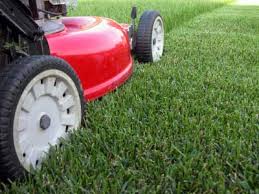
MY TURN column
The Courier-Post
May 21, 2009
by DOUG OTTO
Some in my family think I'm a bit crazy, but I actually enjoy mowing the lawn.
I like taking an unwieldy, ragged patch of grass and transforming it into a neatly manicured, orderly environment. As I move back and forth across my domestic patch of sod, like a weaver's shuttle moving across some giant grassy loom, I feel I am partnering with nature.
When I was 13, I cut lawns to supplement my allowance, and found that I did my best thinking while trailing a lawn mower. Maybe it was the incessant humming of the Briggs & Stratton engine, or the concentration required to keep each row evenly cut with the last, but I found myself enveloped in an impenetrable bubble. I probably should have written a book: Zen and the Art of Lawn Mowing.
As a Boy Scout, I loved working outdoors on conservation projects. Once, I helped rebuild a wilderness road alongside a hidden lake. Each day when I returned to the site, I discovered that nature had delicately changed some aspect of the surroundings, challenging me to discover something new.
On more than one occasion, I have visited "Fairsted" in Brookline, Mass., the century-old home and office of Frederick Law Olmsted, recognized as the Father of American Landscape Architecture, and the designer of many U.S. parks. He designed New York City's Central Park, Boston's Emerald Necklace and portions of Philadelphia's Fairmount Park.
Some nearby projects falling under Olmsted's touch are the Wilmington, DE., parks, the grounds of The Lawrenceville School, Bryn Mawr College and the Morris Arboretum. Olmsted believed that a stroll through a pastoral park setting was an antidote to the stress and artificialness of urban life. He called them "pleasure grounds" and used thick plantings to screen out intrusions of daily life.
I remember walking an Olmsted-designed pathway at Fairsted that twisted and turned, rose upward and then fell away, revealing a variety of low-growing ground covers, medium-sized bushes and tall barked trees, all within less than a half-acre of space. He had created miniature vistas highlighting nature, delighting my spirit with every step taken.
Amid all today's talk of "going green," I hear very little mention of Olmsted's contributions to the movement. Yet he designed (and named) the "parkway" as a way to separate commercial vehicles from recreational ones, created the first park systems and greenways in the country, and launched experiments in scientific forestry. He is also credited with designing the first planned suburb.
One of my early career considerations was to become a landscape architect, like Olmsted. If it hadn't been for poor grades in required math courses, today I might be creating flowering settings instead of flowery words.
On trips to Pinehurst, NC (an Olmsted-designed town), to play golf, I've been known to slow down play on the course while I admire the landscaped fairways, the surrounding topography and the contours leading up to the greens.
It is only fitting that Olmsted's home in Brookline was purchased by the National Park Service and opened to the public as a museum. He designed many of America's most treasured landscapes including the U.S. Capitol and White House grounds, Great Smoky Mountains and Acadia National Parks, and the Yosemite Valley.
In 1870, he said: "We want a ground to which people may easily go when the day's work is done, andwhere they shall, in effect, find the city put far away from them."
I'd like the yard around my house to be like that. Is there anything as restorative as the smell of freshly cut grass? Or the splashy colors of azaleas and rhododendrons in bloom? How about the iridescence of early morning dew?
I can't help but think there's a certain psychological and mythical aspect to all this landscape gardening. Maybe it's the old myths about man and garden originally belonging together - - the Garden of Eden, the Arcadia of ancient Greece or the Elysian Fields.
This spring, I hired the boy across the street to cut my lawn. I watch him throough the window as he revs the engine, places his right foot forward, then his left, pivoting his machine at the end of each precisely cut row.
Vicariously I am with him, moving from front yard to the back yard; trimming, carving, gliding across the grassy surface that I once groomed and managed.
But now, I am content to apprteciate the scene from afar.
Maybe there are some tabletop bonsai trees in my baby boomer future that will at last qualify me as a junior Olmsted.